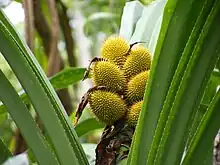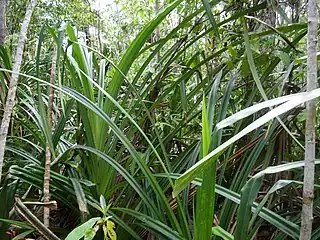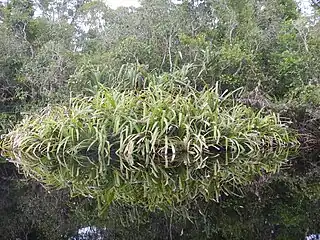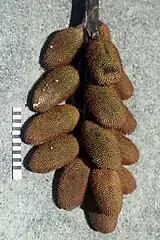| Lauterbach's pandan | |
|---|---|
 | |
| Immature fruit | |
| Scientific classification | |
| Kingdom: | Plantae |
| Clade: | Tracheophytes |
| Clade: | Angiosperms |
| Clade: | Monocots |
| Order: | Pandanales |
| Family: | Pandanaceae |
| Genus: | Benstonea |
| Species: | B. lauterbachii |
| Binomial name | |
| Benstonea lauterbachii | |
| Synonyms[4] | |
Benstonea lauterbachii, commonly known as Lauterbach's pandan, is a shrub or small tree to 15 m (49 ft) in the family Pandanaceae endemic to Cape York Peninsula in Queensland, Australia.[5][6] It was first described as Pandanus lauterbachii in 1900, but was revised in 2012 by Martin Callmander and Sven Buerki who placed it in the newly created genus Benstonea. In Australia it is found from the tip of Cape York to Iron Range, with an isolated occurrence at the Hull River near Tully.[5][6]
Gallery
 Foliage
Foliage Growing in a swamp
Growing in a swamp Infructescence
Infructescence
References
- ↑ "Species profile—Benstonea lauterbachii". Queensland Department of Environment and Science. Queensland Government. 2022. Retrieved 26 April 2023.
- ↑ Jimbo, T. (2022). "Benstonea lauterbachii". IUCN Red List of Threatened Species. 2022: e.T198825558A202837719. doi:10.2305/IUCN.UK.2022-2.RLTS.T198825558A202837719.en. Retrieved 26 April 2023.
- ↑ "Benstonea lauterbachii". Australian Plant Name Index (APNI). Centre for Australian National Biodiversity Research, Australian Government. Retrieved 26 April 2023.
- 1 2 "Benstonea lauterbachii (K.Schum. & Warb.) Callm. & Buerki". Plants of the World Online. Royal Botanic Gardens, Kew. Retrieved 26 April 2023.
- 1 2 F.A.Zich; B.P.M.Hyland; T.Whiffen; R.A.Kerrigan (2020). "Benstonea lauterbachii". Australian Tropical Rainforest Plants Edition 8 (RFK8). Centre for Australian National Biodiversity Research (CANBR), Australian Government. Retrieved 26 April 2023.
- 1 2 Wilson, A.J.G. (2022). Kodela, P.G. (ed.). "Benstonea lauterbachii". Flora of Australia. Australian Biological Resources Study, Department of Climate Change, the Environment and Water: Canberra. Retrieved 26 April 2023.
External links
 Data related to Benstonea lauterbachii at Wikispecies
Data related to Benstonea lauterbachii at Wikispecies Media related to Benstonea lauterbachii at Wikimedia Commons
Media related to Benstonea lauterbachii at Wikimedia Commons- View View a map of historical sightings of this species at the Australasian Virtual Herbarium
- View observations of this species on iNaturalist
- View images of this species on Flickriver
This article is issued from Wikipedia. The text is licensed under Creative Commons - Attribution - Sharealike. Additional terms may apply for the media files.
